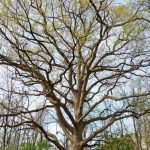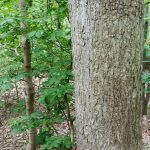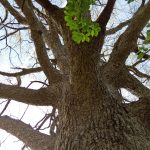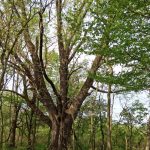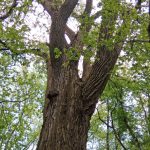It’s Arbor Day in Ohio, Friday April 28, 2017. Why not get out and celebrate this Arbor Day weekend by exploring your Metro Parks for some giants—giant trees, that is. The following are just a very few of the awesome trees you could visit. Follow the links for park directions and trail maps. Perhaps taking in the majesty of these behemoths will inspire you to go out and plant some trees of your own, and leave a legacy for people and wildlife to enjoy for centuries to come.
1. Osage Orange (Maclura pomifera) 54″ diameter
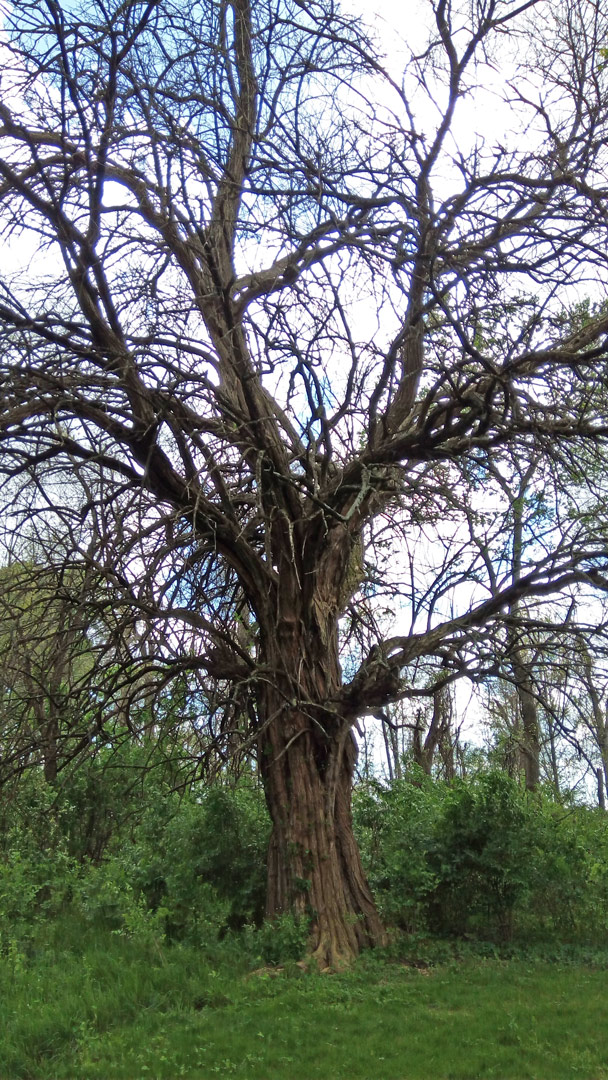
One of our most easily identifiable trees, you’ve likely seen an osage even if you didn’t recognize it. This gnarled and twisted up tree produces hedge apples – a fruit sometimes affectionately known as “monkey brains.” Once valued for their strong wood and ability to provide natural fences, these trees were heavily planted because they made hedgerows that were “horse high, bull strong, and hog tight.” Though sometimes seen as a nuisance now, they still provide great habitat and wildlife value. Also, they are just pretty neat to look at. You can identify these trees by the drooping growth pattern of the branches, deeply furrowed (sometimes orangish) bark, and of course those lime green hedge apples present in the fall.
Where to find: Slate Run – https://www.metroparks.net/parks-and-trails/slate-run/
Just south of the observation deck located on the Bobolink Grassland Trail (purple trail). There is a sign on the trail with more information about this tree.
2. Chinquapin (Chinkapin) Oak (Quercus muehlenbergii) 56″ diameter
You’d be hard-pressed to find another tree more majestic than a mature oak. Beyond their beauty, they provide tremendous value as a food source for wildlife. Oaks are slow-growing and only get this massive after a couple hundred years. When you happen upon an old oak, take a moment to stand beneath it and be humbled by all the changes in the world that tree has weathered. Tree ID on old trees can be tricky at times, and chances are you won’t be able to see the leaves so high up on this one, but you can always tell a chinquapin from other oaks by the much smaller acorns. Look for tiny, dark acorns around the base of these trees in the fall.
Where to find: Sharon Woods – https://www.metroparks.net/parks-and-trails/sharon-woods/
Park in the first parking lot on the left in the Apple Ridge area, on the left-hand side of the lot. This tree is hiding deceptively in plain sight—it is in the treeline to the southwest of the picnic tables, and doesn’t look as large as it is until you walk right up to it.
3. White Ash (Fraxinus americana)57″ diameter
A common and popular urban tree, ash trees have been decimated by the emerald ash borer (EAB), an invasive beetle introduced to the United States via shipping pallets. EAB has had a devastating impact on the ecology of our forests, as ash are some of the earliest colonizers and a staple to young forests. Metro Parks staff have worked diligently to treat some of our most important trees, in hopes of saving a seed source and maintaining the beauty of our natural areas. This white ash has not been treated, and unfortunately is not doing so well. Make sure you get out to see this one while you can.
Where to find: Pickerington Ponds – https://www.metroparks.net/parks-and-trails/pickerington-ponds/
Park at the Wood Duck Picnic Area, and follow the Killdeer Trail toward Pintail Marsh. This ash should stick out as easily the largest tree on the left-hand side.
4. Ohio Buckeye (Aesculus glabra) 23″ diameter
At first glance, this Ohio Buckeye may not look as impressive as the rest, but don’t be dismayed. Buckeyes are understory trees that don’t get as big as the others, so as the species goes, this one’s a monster. You can identify this tree by the compound leaf with five leaflets, which have a foul odor when crushed. (It’s also known as the fetid buckeye for this reason.) Of course, you’ll also find the characteristic buckeyes on the ground in the fall. Show some Ohio pride and go hug our state tree this weekend.
Where to find: Three Creeks – https://www.metroparks.net/parks-and-trails/three-creeks/
Park in the Confluence Trails Area – Following the Bluebell Trail, this tree will be on the right just before you reach the floodplain. The leaves are too far up on the tree to distinguish, but luckily there are several small buckeyes surrounding it that you can use as identifiers.
5. Eastern Cottonwood (Populus deltoides) 83″ diameter
A very fast-growing tree of wet areas and floodplains, the eastern cottonwood is often overlooked and under appreciated. Though it is much larger than the oak mentioned earlier, due to its growth rate it is probably only half as old. These trees are highly susceptible to wind and weather as they age, so to see a tree this large in good condition is a great find. You’ll recognize the cottonwoods in this area by the deeply fissured bark—most of the leaves will be too high to see.
Where to find: Scioto Grove – https://www.metroparks.net/parks-and-trails/scioto-grove/
Many large cottonwood and sycamore trees can be seen by strolling along the REI River Trail. From the North Canoe Access, follow the trail around the bend and this tree will be on the left hand side shortly before the trail splits.
We’d love to know about your Arbor Day adventures this weekend. Post your pictures of great trees in the parks to our Facebook page or tag #cbusmetroparks on Instagram.
Identification tips and more information about these species can be found here: http://forestry.ohiodnr.gov/trees
To learn more about some other Ohio giants, visit http://forestry.ohiodnr.gov/championtrees
ALYSSA BALTER
Restoration Ecologist
- A very old chinquapin oak at Sharon Woods. (Alyssa Balter)
- This Ohio buckeye at Three Creeks has a very impressive 23-inch diameter trunk, very large for a buckeye. (Alyssa Balter)
- The impressive upper branches of a very old chinquapin oak at Sharon Woods. (Alyssa Balter)
- A large white ash tree at Pickerington Ponds. (Alyssa Balter)
- A giant cottonwood tree at Scioto Grove Metro Park. (Alyssa Balter)

